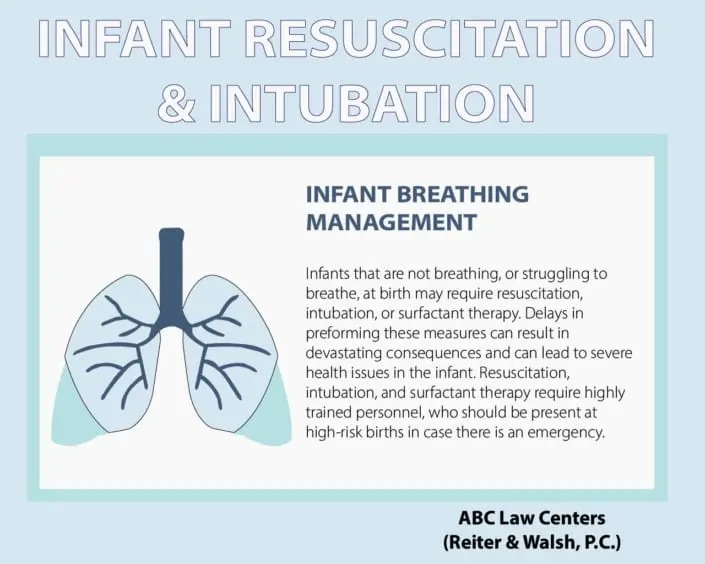Neonatal Resuscitation
Infants that are not breathing or struggling to breathe at birth may require resuscitation, intubation, or surfactant therapy. The term resuscitation refers to a revival from a state of unconsciousness; in some cases, the infant may appear to be dead prior to resuscitation. Intubation is the process of inserting a tube into the trachea (through the mouth or nose) to maintain an open airway. The tube can also be attached to a ventilator. Surfactant is a substance that is produced by the lungs. If an infant does not have enough surfactant, doctors will need to administer surfactant therapy. This will allow the lungs to properly expand and take in the oxygenated air (1). Delays in performing resuscitative measures, intubation, or surfactant therapy can result in devastating consequences. Moreover, mistakes made while attempting resuscitation, intubation, and surfactant therapy can vastly increase the risk that a baby will have severe health issues. These procedures require highly trained personnel, who should be present at high-risk births in case there is an emergency (1, 2).
Importance of being prepared for breathing intervention
Most infants transfer from life inside the womb to life outside without the need for any special assistance. However, about 10% of babies need some intervention, and 1% will require extensive resuscitative measures at birth (2). Thus, medical personnel who are properly trained should be readily available to perform neonatal resuscitation at every birthing location, whether or not problems are anticipated. Preterm infants are more likely to require resuscitation and develop complications from it, compared to term infants (2). If a preterm birth is anticipated and time permits, the mother should be transferred to a perinatal center (a center that specializes in high-risk births) prior to delivery.
A delay in performing any of the resuscitative maneuvers described below can result in the baby being deprived of oxygen and adequate blood flow. This can cause damage to the baby’s organs, including the heart and brain. Early intervention is crucial when a baby needs resuscitation.
Did your child suffer a resuscitation error?
Contact ABC Law Centers today and secure your child’s care and reclaim their future.

Risk factors for neonatal resuscitation
Infants who are at risk for needing resuscitation can be identified by certain risk factors, as well as the presence of complications that occurred during pregnancy or labor and delivery. The following are risk factors associated with the need for breathing assistance at birth (2):
Maternal medical conditions
If a mother has certain factors that make her pregnancy high-risk, her child has a higher risk of needing breathing assistance at birth. The following are maternal conditions that increase the likelihood of neonatal resuscitation at birth (2):
- Advanced maternal age, or very young maternal age
- Gestational diabetes
- Maternal hypertension
- Substance abuse
- Prior stillbirth, miscarriage, or neonatal death
Fetal/pregnancy conditions
During pregnancy, the fetus may show risk factors correlated with the need for neonatal resuscitation. In addition, some pregnancy complications may arise that also increase this risk. Below are some common examples (2):
- Premature birth
- Postterm pregnancy
- Genetic/congenital anomalies
- Intrauterine growth restriction (IUGR)
- Multiple gestations (e.g. twins, triplets, or more)
- Placenta previa
- Placental abruption
- Oligohydramnios (low amniotic fluid) or polyhydramnios (an excess of amniotic fluid)
- Transverse lie or breech presentation
- Chorioamnionitis
- Meconium-stained fluid (or foul-smelling amniotic fluid)
- Birth asphyxia (HIE)
- Abnormal fetal heart rate patterns
- Mechanical delivery (i.e. the use of forceps or vacuum extractors)
- Emergency C-section
Medical personnel (including physicians) who are adequately trained and skilled in neonatal resuscitation should be present at every high-risk birth. In addition, equipment for resuscitation should be present at the birth (2).
Neonatal resuscitation: steps
At birth, all babies (whether term or preterm) should be evaluated on their muscle tone and ability to breathe and cry. In the assessment of a term newborn, if it is found that the baby has good muscle tone and is able to both breathe and cry, they likely will not need resuscitative assistance. However, if the baby is preterm, has poor muscle tone, and/or has difficulty breathing or crying, neonatal resuscitation may be necessary (2).
If it is determined that neonatal resuscitation is necessary, medical professionals should move through the steps outlined below. If after a particular step the baby responds with spontaneous respiration and a heart rate greater than 100 bpm, no further steps should be taken. However, if after a step a baby is still gasping, has apnea or labored breathing, has cyanosis, or has a heart rate less than 100 bpm, medical professionals should continue to the next step. These steps are outlined below (2):
- Initial stabilization: Medical professionals should warm, dry, and properly position the baby. They should also provide tactile stimulation and clear the baby’s airway if necessary.
- Breathing assistance: At this point, the baby should either be ventilated or oxygenated, depending on the circumstances. If the baby has a heart rate of < 100 bpm and has apnea/is gasping they should be given positive pressure ventilation (PPV). Newborns with a heart rate > 100 bpm with labored breathing or cyanosis should be given supplemental oxygen and the use of continuous positive airway pressure (CPAP) should be considered. Both of these breathing assistance techniques will be covered in greater detail below.
- Chest compressions: Chest compressions are often used if the newborn’s heart rate stays under 60 bpm despite adequate ventilation for 30 seconds.
- Epinephrine administration: Epinephrine, a hormone and intervention for resuscitation, can be administered intravenously if the above steps failed to provide assistance.
- Volume expansion: Though rarely used, volume expansion can be administered in order to prevent neonatal hypovolemia (decreased amount of blood flowing through the body) if the baby’s heart rate stays < 60 bpm after the above steps.
Neonatal resuscitation interventions and procedures
Airway clearance/suctioning
Breathing issues in the newborn may appear when mucus or secretions block the airway. In these circumstances, a tube is placed in order to draw out or aspirate the blockage. When an infant has suffered from meconium aspiration, a special ET suctioning tube is used. Only babies with an obvious obstruction after birth are immediately suctioned (2). The risks involved with airway suctioning include hypoxemia, bradycardia, hypotension, reduced oxygen availability, and pneumothorax (11).
Positive pressure ventilation (PPV)
When babies needs help breathing, medical professionals often turn to positive pressure ventilation (PPV). PPV provides newborns with air via a mask, inflating bag, or T-piece resuscitator (which includes an airflow control valve). PPV is designed to improve the exchange of air between the lungs and the outside world (2, 3). PPV is indicated if the baby’s heart rate is < 100 bpm, they are apneic, or they are gasping for breath (2). There are certain risks and complications associated with PPV in the newborn population, including (2, 4):
- Ineffective ventilation due to leaks in the mask
- An excess of air moving to the baby’s stomach, if a mask is used
- Vomit aspiration, if a bag is used
- Over- or under-ventilation
- Pulmonary air-leak
- Lung or airway injury
- Bronchopulmonary dysplasia (a chronic lung disease)
- Retinopathy of prematurity (the formation of scar tissue behind the eye)
Continuous positive airway pressure (CPAP)
Continuous positive airway pressure (CPAP) is a non-invasive method used to help a baby breathe. Physicians typically try CPAP before they move to the invasive method of ventilatory support, endotracheal intubation (discussed below). During CPAP administration, the baby wears a mask or nasal prongs and a machine delivers continuous pressure to keep the baby’s lungs open. Forms of CPAP such as non-invasive positive pressure breathing (NIPPV) give the baby a set amount of full breaths (breaths that the baby does not have to initiate) to give the baby additional breathing assistance (1, 2).
CPAP is indicated for neonates when the following conditions are present (7):
- Respiratory acidosis
- Respiratory distress syndrome
- Recurrent apnea or other labored breathing
- Apnea of prematurity
- Atelectasis (a condition in which parts of the lungs collapse)
Complications associated with neonatal CPAP use include skin reactions, air leaks, over- or under-ventilation injuries, pneumothorax (collapsed lung), and more (7).
Endotracheal intubation
Endotracheal intubation is the placement of an endotracheal tube to allow direct access to the upper trachea for delivery of PPV. The tube can be placed through the nose and into the trachea, or through the mouth and into the trachea (2).
Intubation may be necessary if PPV by way of the above methods is ineffective, if chest compressions are being performed, or if signs of respiratory/ventilatory failure (discussed in detail below) are present (2). In addition, intubation can be used to relieve airway obstructions and secretions (5).
Intubation comes with its own set of risks and complications including hypoxia (if the intubation process takes too long), placement injuries, contamination risks, and the possibility of inhaling vomit (6).
Watching chest movement and listening with a stethoscope for breath sounds on both sides of the chest can help ensure proper placement of the tube. A quick, bedside chest x-ray can verify placement (2).
Chest compressions
When performing chest compression on an infant, two or three fingers are used to gently press down on the center of the baby’s chest to help push blood through the heart and surrounding vessels. Neonatal chest compressions should always be accompanied by PPV. Chest compressions are indicated when a baby’s heart rate remains below 60 bpm despite adequate oxygenation (via PPV or intubation) for 30 seconds (2).
If chest compressions are not done with skill, the baby could suffer injuries to the heart, ribs, chest, lungs, and liver (2).
Supplemental oxygen administration
Oxygen is the most commonly administered medication in the delivery room and is often a life-saving measure for newborns in need of breathing assistance (8). As with all resuscitation procedures, the medical team must follow guidelines and target ranges for oxygen levels to ensure that the baby receives enough oxygen. Medical professionals use pulse oximetry, a test used to measure the oxygen saturation of the blood, to determine when the administration of oxygen is appropriate in the newborn population (2).
Supplemental oxygen administration carries serious risks. In fact, the standard of using 100% oxygen whenever supplemental oxygen is called for has been called into question. The use of too much oxygen can cause complications such as retinopathy of prematurity (ROP), collapsed or damaged lungs, bronchopulmonary dysplasia, and more (2, 9). Due to these risks, it is now recommended that either “blended oxygen” (not 100% oxygen) or room air be used in initial resuscitation efforts, especially in premature infants (2).
Surfactant therapy
Surfactant is a substance produced by the lungs that assists with breathing and helps to prevent injury and infection in the lungs. When respiratory distress syndrome (RDS) is present, a baby fails to make enough surfactant, thereby preventing the lungs from expanding properly. In cases of RDS, especially in preterm babies, surfactant can be administered in order to keep the lungs from sticking together, and can be an effective treatment for breathing assistance. Surfactant therapy is indicated when, after CPAP therapy, an infant still suffers with severe respiratory distress (1). Risks of surfactant administration include bradycardia, hypoxemia, pulmonary hemorrhage, and hyperventilation (10).
Medications
Medications are rarely indicated in newborn resuscitation. However, if a newborn’s heart rate remains less than 60 bpm despite adequate ventilation, oxygen administration, and chest compressions, certain drugs may be used. Epinephrine may be used to increase the volume of blood pumped by the heart in an attempt to regulate a newborn’s heart rate. Volume expansion drugs may be used when blood loss is known or expected in order to increase the baby’s blood volume. Both Epinephrine and volume expansion drugs should be used only in specific circumstances (2).
Monitoring during neonatal resuscitation
When resuscitation procedures are started, it is crucial to monitor the baby’s temperature, blood pressure, and heart rate, as well as the oxygen level in the blood. The following are techniques used to monitor newborns during resuscitation:
- Pulse oximetry: Pulse oximetry is a method of continuously monitoring a newborn’s oxygen saturation (the amount of oxygen in a baby’s blood). A sensor is placed on the baby’s finger or toe, and a wire connects this sensor to a machine that continuously displays the oxygen level in the baby’s blood (2, 13).
- Umbilical arterial catheter: An umbilical artery catheter (UAC) allows blood to be sampled from the baby at different times, without repeated needle sticks. This catheter should be placed in the baby immediately after birth if there is any suspicion that the baby could have heart or breathing problems. It is used to continuously monitor the baby’s blood pressure, and to sample arterial blood that shows the baby’s oxygen level as well as crucial information about organ function. This is the most accurate way to measure the oxygen, carbon dioxide, and pH levels of the baby’s blood (14).
- Blood pressure cuff: If UAC is not feasible, a blood pressure cuff can be used to measure blood pressure. A small machine is connected to a cuff wrapped around the baby’s arm or leg, which automatically takes the baby’s blood pressure at regular times and displays the numbers on a screen (15, 16).
- Cardiopulmonary monitor: In most cases, the baby should be attached to a cardiopulmonary monitor, which is a machine that tracks the baby’s heart rate and breathing. It is connected to the baby by small adhesive monitoring pads placed on the chest. A monitor displays information on the screen, which can be printed on paper (16).
No fee unless we win or settle your case.
Secure your child’s future. Call the trusted birth injury attorneys at ABC Law Centers now.
Neonatal resuscitation mistakes
It is essential that the medical team be skilled in resuscitative procedures. Slow or improper performance of these procedures – and failure to perform procedures when indicated – can critical deprivation of adequate oxygen and blood flow to the baby. Seconds matter during resuscitation, and deprivation of oxygen and blood can lead to disability and permanent brain injuries, including hypoxic-ischemic encephalopathy (HIE), cerebral palsy, periventricular leukomalacia (PVL), and brain bleeds. The type and severity of the brain damage depend on many factors, including how long the baby was deprived of adequate blood flow and oxygen. Accurate monitoring of the baby’s vital signs and medical status also is critical.
If a medical team fails to quickly and appropriately carry out resuscitation procedures when indicated, it is negligence. If this negligence leads to an injury in the baby, it is medical malpractice.


Award-winning birth injury attorneys helping children with injuries from neonatal resuscitation mistakes
ABC Law Centers (Reiter & Walsh, P.C.) was established to focus exclusively on birth injury cases. Since the firm’s inception in 1997, our legal team has handled a number of cases involving neonatal resuscitation errors and related birth injuries. We’ve helped clients across the United States receive favorable verdicts and settlements they can use for lifelong care. We charge no fee throughout the entire legal process unless we win your case.
- Free Case Review
- Available 24/7
- No Fee Unless We Win
Featured Videos
Posterior Position
Hypoxic-Ischemic Encephalopathy (HIE)

Featured Testimonial
What Our
Clients Say…
After the traumatic birth of my son, I was left confused, afraid, and seeking answers. We needed someone we could trust and depend on. ABC Law Centers was just that.
- Michael
Helpful resources
- Martin, R. (2019, February). Prevention and treatment of respiratory distress syndrome in preterm infants. Retrieved from https://www.uptodate.com/contents/prevention-and-treatment-of-respiratory-distress-syndrome-in-preterm-infants.
- Fernandes, C. J. (2019, January). Neonatal resuscitation in the delivery room. Retrieved from https://www.uptodate.com/contents/neonatal-resuscitation-in-the-delivery-room.
- Shiel, W. C., Jr. (n.d.). Definition of Positive pressure ventilation. Retrieved from https://www.medicinenet.com/different_types_of_mechanical_ventilation/article.htm.
- Fraser, D. (n.d.). 10 Complications of Positive Pressure Ventilation. Retrieved from http://www.academyofneonatalnursing.org/NNT/Respiratory_ARC3_10ComplicationsPPV.pdf.
- Dagle, J. (2018, December 06). Technique for insertion of an endotracheal (ET) tube. Retrieved from https://uichildrens.org/health-library/technique-insertion-endotracheal-et-tube.
- Neonatal Intubation. (1994, November). Retrieved from https://www.utmb.edu/policies_and_procedures/Non-IHOP/Respiratory/Respiratory_Care_Services/07.03.44 Neonatal Intubation.pdf.
- The Royal Children’s Hospital Melbourne. (n.d.). Retrieved from https://www.rch.org.au/rchcpg/hospital_clinical_guideline_index/Continuous_Positive_Airway_Pressure_(CPAP)_-_Care_in_the_Newborn_Intensive_Care_Unit_(Butterfly_Ward)/.
- Kapadia, V. (2018, March 07). Oxygen Therapy in the Delivery Room: What Is the Right Dose? Retrieved from https://www.sciencedirect.com/science/article/pii/S0095510818300149?via=ihub.
- Jobe, A. H., & Kallapur, S. G. (2010, August). Long term consequences of oxygen therapy in the neonatal period. Retrieved from https://www.ncbi.nlm.nih.gov/pmc/articles/PMC2910185/.
- Canadian Paediatric Society. (2005, February). Recommendations for neonatal surfactant therapy. Retrieved from https://www.ncbi.nlm.nih.gov/pmc/articles/PMC2722820/.
- Gonçalves, R. L., Tsuzuki, L. M., & Carvalho, M. G. (2015). Endotracheal suctioning in intubated newborns: An integrative literature review. Retrieved from https://www.ncbi.nlm.nih.gov/pmc/articles/PMC4592124/.
- Abdel-Hady, H., Nasef, N., Shabaan, A. E., & Nour, I. (2015, November 08). Caffeine therapy in preterm infants. Retrieved from https://www.ncbi.nlm.nih.gov/pmc/articles/PMC4637812/.
- Dawson, J. A., Davis, P. G., O’Donnell, C. P., Kamlin, C. O., & Morley, C. J. (2007, January). Pulse oximetry for monitoring infants in the delivery room: A review. Retrieved from https://www.ncbi.nlm.nih.gov/pmc/articles/PMC2675297/.
- Umbilical artery catheterisation for neonates. (2014, May). Retrieved from https://bettersafercare.vic.gov.au/resources/clinical-guidance/maternity-and-newborn-clinical-network/umbilical-artery-catheterisation-for-neonates.
- Blood Pressure Cuff. (n.d.). Retrieved from https://www.easyauscultation.com/blood-pressure-cuff.
- Common NICU equipment. (n.d.). Retrieved from https://www.marchofdimes.org/find-support/topics/neonatal-intensive-care-unit-nicu/common-nicu-equipment.






















